There is ponding on nearly every field in the valley where the rivers Severn and Vyrnwy meet on the English-Welsh border. Swollen rivers have been sluggishly sitting in the valley for months. Inhabitants’ attempts to protect their homes from flooding are part of a losing battle played out across the country.
The UK’s flooding this year is a story of desperation – but also hope, says John Hughes, development manager at Shropshire Wildlife Trust, who works in the valley. Following widespread acceptance of the climate and ecological emergency, Hughes believes people are increasingly looking to nature for solutions.
George Eustice, the environment secretary, has announced that GBP4bn will be spent on flood defences in the next five years and said a “big part of our focus is going to be nature-based solutions upstream”.
Hughes says: “The media normally have a distinct agenda when it comes to floods which is: ‘how miserable have you been?’ This time around the interviews I heard were talking about natural solutions and I’d never heard that before.
“I say thanks very much Extinction Rebellion and Greta [Thunberg] – you’ve done a great job. It’s the job we’ve been trying to do for 50 years. We need to take a holistic view – land can do many, many things.”
Soils
In the past, flood plains acted like sponges that soaked up water and stopped it flowing headlong into settlements downstream. Wetter habitats provided useful materials such as willow and reeds for baskets and thatched roofs. However, natural wet woodland, neutral grassland, fens and marshes were ironed out of the postwar landscape and now cover just 11% of English and Welsh flood plains. Intensive agriculture covers 70%.
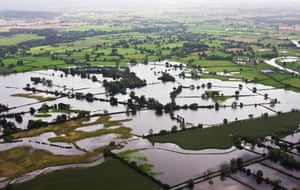
Crops such as maize, potatoes, asparagus and onions are harvested as late as October because of the milder UK climate. This means fields are often left bare over winter months after heavy machinery has compacted the soil. This leaves the land unable to soak up so much water.
“When you drive heavy vehicles on soggy soil you make a mess,” says John Quinton, professor of soil science at Lancaster University. “You’ve then destroyed the soil structure, and because of that water can’t get into the soil very quickly. The water runs over the surface of the soil and picks up the soil and deposits it in rivers or elsewhere. If soils are in good condition, the water will go into the soil and you will have a lot of storage.”
Scientists say creating grassland, giving land rest periods and avoiding the use of heavy machinery in flood-prone areas will reduce nutrient and sediment loss from fields. “Some groups of farmers are definitely moving in the right direction. When I started my career in the late 80s we weren’t talking about soil erosion or nutrient losses. Things are changing,” says Quinton.
Experts are only beginning to understand the complexity of soil ecosystems. In the flood-hit village of Eaton Bishop in Herefordshire, farm conservation adviser Caroline Hanks compares two spadefuls of soil from the same field near her house – one from the middle of the field where intensively farmed maize was harvested in October, and the other from under tussocky grass by the hedge. The first sample is root-free and heavily compacted, meaning water cannot percolate more than eight inches below the surface. The second spadeful is crumbly, full of roots and moist throughout. The two samples look – and smell – different.
“We’re trying to give people a visual way to assess their soil. It’s such a simple technique – you can tell so much from a spadeful of soil,” says Hanks, who specialises in advising farmers on creating flower-rich grassland. “Twenty years ago people expected us to focus on birds and hedgerows and field edges but these days getting a spade out and looking at soil is a core part of the visit.”
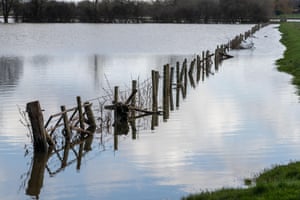
According to Quinton’s Defra-funded research there is between three and 10 times more water run-off from compacted soils than healthy soils. “That rotten egg smell you get from compacted soils is certainly something that says to me that’s an unhealthy soil,” he says. “It shows that it’s compacted and its normal biology isn’t functioning very well. In the soil that’s aerated you’ve got fungi and bacteria which are active and sometimes after rain, you get that sweet smell of damp soil, and it’s actually a compound called geosmin.”
Creating rough landscapes
Many natural flood-management techniques involve reinstating features that were once common to fields such as ponds, hedges and leaky dams (either created by fallen trees or beavers). Creating buffer strips, wooded areas, drainage ditches and re-meandering rivers are all part of the toolkit. The overall effect is to give the landscape more structure and roughness to counterbalance the way industrialised farming has smoothed it out.
The problem is that reducing food production is currently counterintuitive to most farmers’ business plan, says Dr Marc Stutter, a soil and water scientist at the James Hutton Institute. “The biggest thing we’re fighting against is that the farmers and their fathers and grandfathers have been very proud of the way they’ve brought the land into condition for crops and quite rightfully so. Their parents have spent a lot of effort draining the land and now there’s someone telling them they want pockets of it to be wet up again.
“If we could reverse it and say they’re not just farmers of a crop but stewards of the land then we might be able to think of water quality and flood resistance as part of their overall job.”
Natural flood management has other benefits – planting trees and hedges helps to create vital habitats for nature and locks away carbon. Creating buffer strips along streams and rivers helps filter out pollutants and improves water quality.
However, nature-based solutions are no silver bullet, according to analysis by the University of Oxford which found they would be overwhelmed by the sort of floods seen in the UK this winter.
Making the land more absorbent should be used alongside traditional “hard engineering” techniques such as flood walls, says Hannah Cloke, professor of hydrology at the University of Reading.
“Putting beavers in the River Thames is not going to keep people dry and a different solution is required. However, for some of the smaller communities you could implement woody debris dams and make sure the soil upstream is able to absorb the water. Not one size fits all. It must be an open discussion between farmers and Defra and the Environment Agency and scientists. It’s not an easy problem but I think we should be confident that we can solve it,” she says.
Case studies
In 2015 Glenridding, a village at the bottom of Helvellyn in the Lake District, was one of many communities trashed by Storm Desmond.
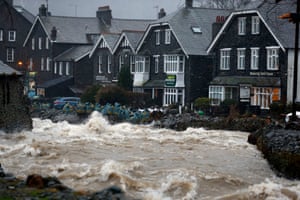
Danny Teasdale, a mechanic from the village, decided to do something. “Flooding isn’t going to go away, we’ve got to start looking at things. There are extreme conservationists on one side and extreme farmers on the other and they keep clashing heads and nothing happens. I sit in the middle … I know the local farmers and they trust me,” he says.
In the valley above the village, Teasdale created a wiggly upstream release channel that runs parallel to the river and fills up only when the river is full. He worked with the local farmer and the Environment Agency. The GBP6,000 project was funded by a local flood action group.
Teasdale says: “We’ve just had really, really heavy rain with Storm Ciara and Storm Dennis – I think some of the heaviest since Storm Desmond – and it didn’t flood this time. So it’s looking like it’s been helping. It goes hand in hand with hard engineering in the village but if you can slow things down upstream you don’t need to build your walls so high.”
Teasdale’s work was so successful he created a community interest group called Ullswater Catchment Management CIC in November 2018. He has since worked in a number of different catchments around Ullswater with the Woodland Trust, Natural England and the Environment Agency, including planting 2,000 trees in Grisedale valley at a cost of GBP8,000 and a project to re-wiggle the river in Matterdale that cost GBP14,000.
“It’s peanuts compared to the money that goes into hard engineering,” explains Teasdale, who says GBP2m has already been spent on hard flood defences in Glenridding.
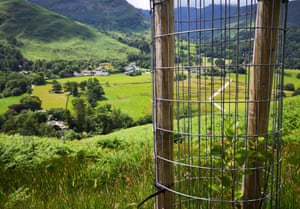
Elsewhere in the Lake District, the RSPB led a similar river re-wiggling scheme in Swindale valley. The work cost GBP200,000 and involved letting the river meander back into its old course after being straightened by hill farmers looking to dry out land hundreds of years ago. The valley is a kilometre long and the river is now 180 metres longer.
“It’s all about holding that water in the higher catchments for longer,” says Lee Schofield, a site manager at RSPB Haweswater. “Having a wiggly river means they move more slowly. We’re delaying flood peak – it’s a low-tech solution that delivers many other benefits and makes the landscape much more resilient.”
Paul Quinn, a senior lecturer in catchment hydrology at Newcastle University, believes more drastic landscape measures, called catchment systems engineering (CSE), are needed to compensate for the fact that flood plains are already full of houses and roads. More than 40% of rivers have been deepened or modified so that they are no longer connected to their flood plains.
“In a beautiful world that doesn’t exist, we could get our soil back into good condition and that would actually stop a lot of floods. But when the big floods come along – the kind that climate change is going to produce – soil management is not going to do it,” he says.
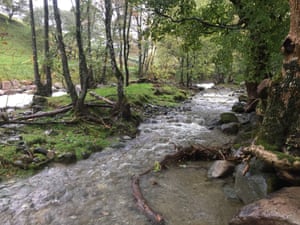
“CSE is halfway between nature-based solutions and something that’s a bit like traditional flood management which is usually big dams, big ponds and big walls. We need to start spreading them out over the whole catchment system. It seems to me such a simple idea. It’s not rocket science, it’s about storing water – and large amounts of it – at every opportunity you can.”
Quinn’s approach includes natural solutions as well as features such as the creation of large retention ponds and cascading channels. His team built 35 ponds and dams, and created 10 zones of oak, beech and willow plantations in the catchment attached to the village of Belford in Northumberland which has been badly affected by flooding. The scheme cost GBP200,000 and in the seven years since the work was completed the village has not flooded. “Every single catchment in the country will have to be done,” he says.
What next?
In terms of soils, Quinton believes people’s attitudes are already changing: “I sense a shift in the farming community with a much greater emphasis on soils and how to sustain them. I have no evidence for this, except talking to farmers and watching Twitter. I get the feeling that there is increasing recognition that protecting soils is vital for the sustainability of the farm business.”
Farmers think of food production as their primary motivation because that is what they have been subsidised to do. Rather than trying to farm flood-prone areas of land that don’t yield much, farmers may be subsidised to manage them for nature. Many feel the government is making the right noises with policies laid out in the new Environmental Land Management Scheme (ELMS) – which will be fully implemented by 2028.

A Defra spokesperson told the Guardian that natural flood management would be an important part of protecting the nation from flooding. “ELMS will reward farmers for the public goods that they provide, including protecting communities from environmental hazards such as flooding. Natural England and the Environment Agency do vital work and we continue to work closely with both agencies to ensure they have the right resources to continue to do so.”
Soil management has featured prominently in ELMS – with funding set to be available for measures such as no-till agriculture and maintaining water in peat soils – but conservationists are worried that the devil is in the detail.
Teasdale says: “I’ve seen what the government has done to Environment Agency and Natural England and what they’ve done to their budget, and it’s criminal. They’ve slashed it. ELMS could potentially be good but it needs to be funded properly and that’s what I’m not sure about. I’d love to be wrong.”
Find more age of extinction coverage here, and follow biodiversity reporters Phoebe Weston and Patrick Greenfield on Twitter for all the latest news and features